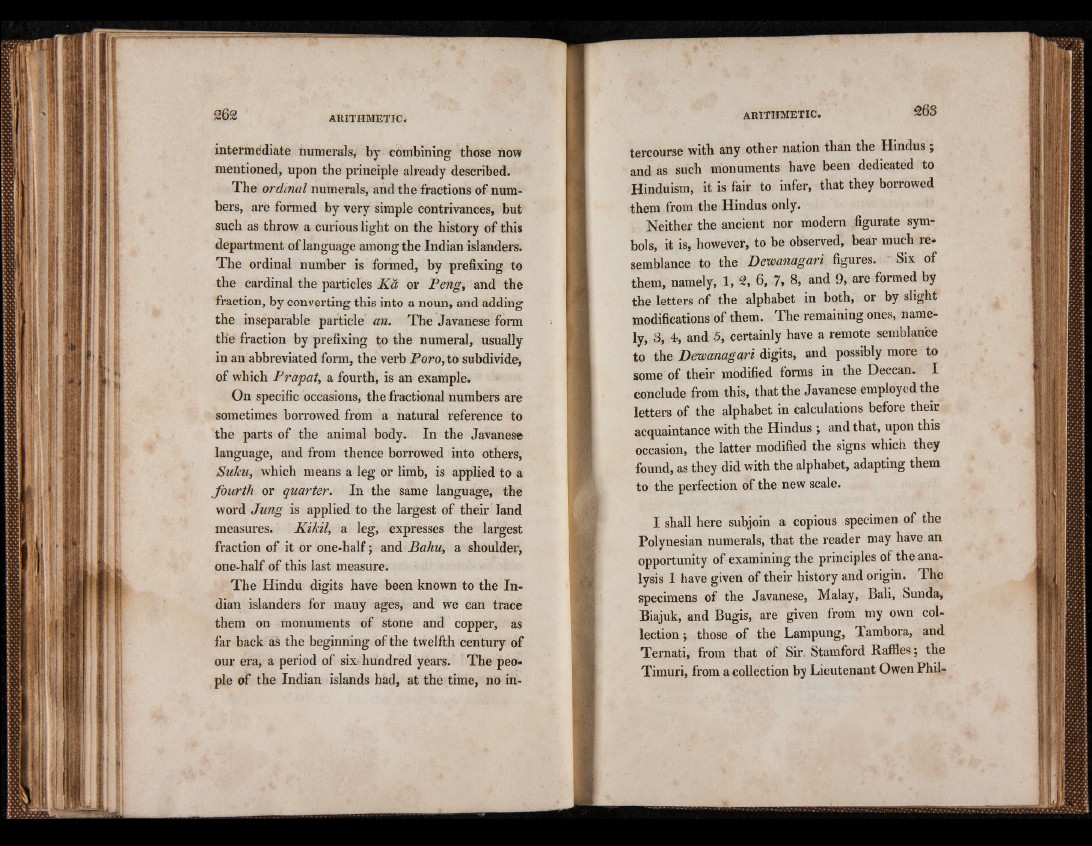
intermediate numerals, by combining those now
mentioned, upon the principle already described.
The ordinal numerals, and the fractions of numbers,
are formed by very simple contrivances, but
such as throw a curious light on the history of this
department of language among the Indian islanders.
The ordinal number is formed, by prefixing to
the cardinal the particles Kd or Peng, and the
fraction, by converting this into a noun, mid adding
the inseparable particle an. The Javanese form
the fraction by prefixing to the numeral, usually
in an abbreviated form, the verb Poro, to subdivide,
of which Prapat, a fourth, is an example.
On specific occasions, the fractional numbers are
sometimes borrowed from a natural reference to
the parts of the animal body. In the Javanese
language, and from thence borrowed into others,
Suku, which means a leg or limb, is applied to a
fourth or quarter. In the same language, the
word Jung is applied to the largest of their land
measures. Kikil, a leg, expresses the largest
fraction of it or one-half ; and Bahu, a shoulder,
one-half of this last measure.
The Hindu digits have been known to the Indian
islanders for many ages, and we can trace
them on monuments of stone and copper, as
far back as the beginning of the twelfth century of
our era, a period of six hundred years. The people
of the Indian islands had, at the time, no intercourse
with any other nation than the Hindus ;
and as such monuments have been dedicated to
Hinduism, it is fair to infer, that they borrowed
them from the Hindus only.
Neither the ancient nor modern figurate symbols,
it is, however, to be observed, bear much resemblance
to the Dewanagari figures. ' Six of
them, namely, 1, & 6, 7, 8, and 9, are formed by
the letters of the alphabet in both, or by slight
modifications of them. The remaining ones, namely,
3, 4, and 5, certainly have a remote semblance
to the Dewanagqri digits, and possibly more to
some of their modified forms in the Deccan. I
conclude from this, that the Javanese employed the
letters of the alphabet in calculations before their
acquaintance with the Hindus ; and that, upon this
occasion, the latter modified the signs which they
found, as they did with the alphabet, adapting them
to the perfection of the new scale.
I shall here subjoin a copious specimen of the
Polynesian numerals, that the reader may have an
opportunity of examining the principles of the analysis
I have given of their history and origin. The
specimens of the Javanese, Malay, Bali, Sunda,
Biajuk, and Bugis, are given from my own collection
; those of the Lampung, Tambora, and
Ternati, from that of Sir. Stamford Raffles; the
Timuri, from a collection by Lieutenant Owen Phil